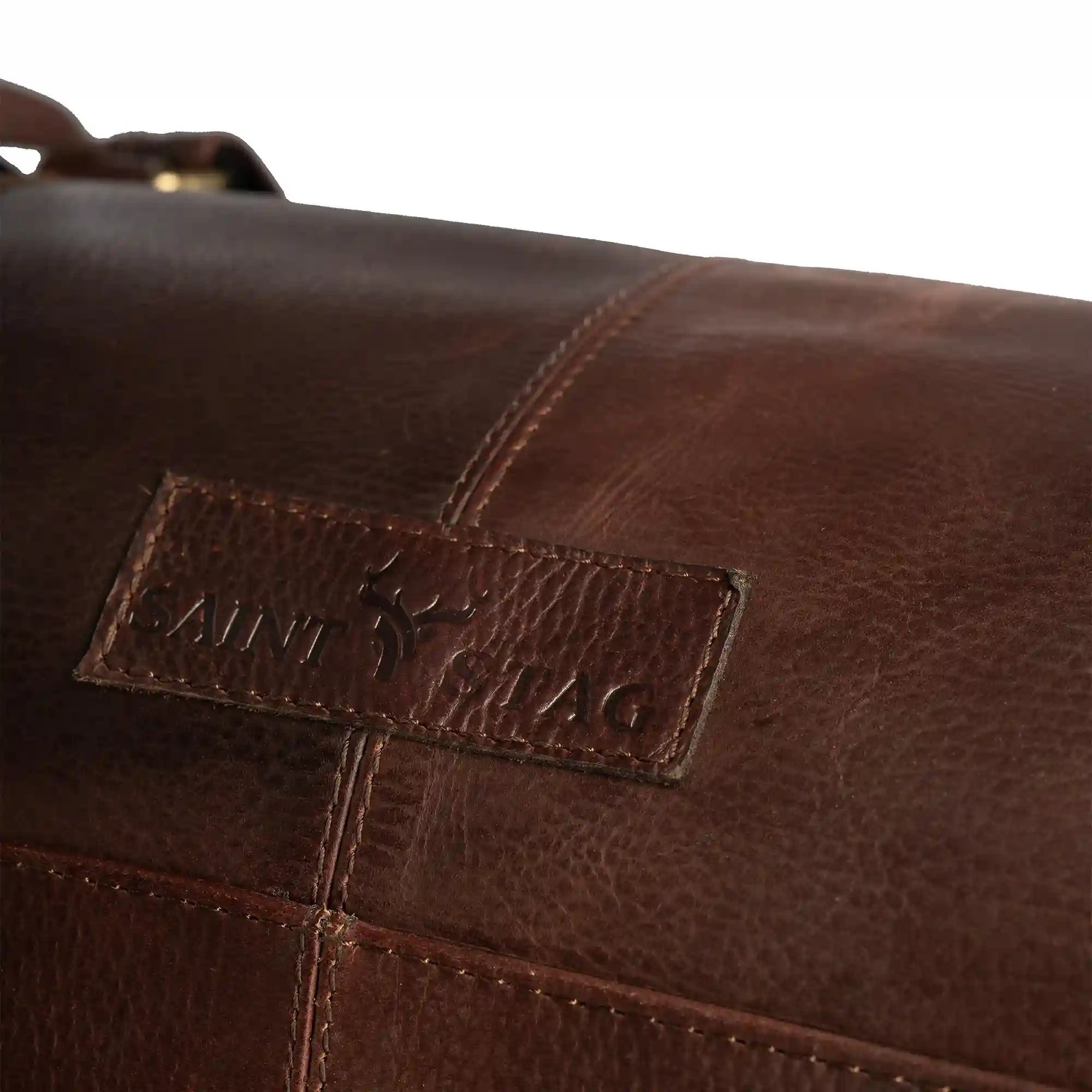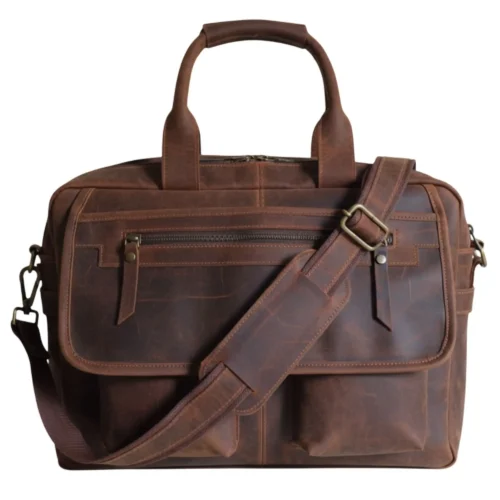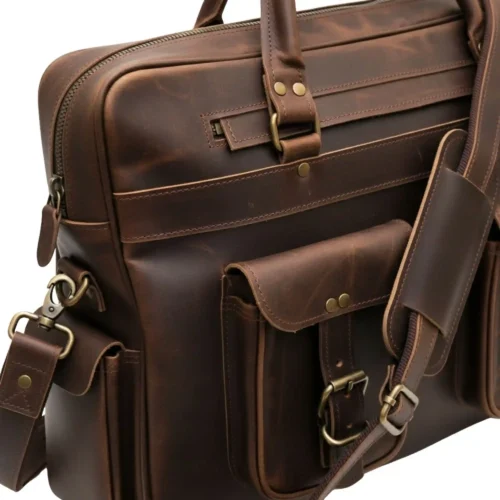
🚛 FREE SHIPPING | LIFETIME REPAIR WARRANTY | 20% Sale: “FREEDOM20”

Ever wondered if your travel choices can be both stylish and kind to the planet? For many, the idea of owning a beautiful leather duffle bag evokes images of classic elegance and adventurous journeys. But what if we told you that choosing a vintage leather duffle bag isn’t just a nod to timeless fashion, it’s also a powerful statement about sustainability.
Forget the fleeting trends. Embracing a vintage leather duffle means opting for quality that has already stood the test of time. It’s about choosing a product with a story, a unique character that only years can bestow, and a significantly smaller environmental footprint than its brand-new counterparts.
In a world increasingly focused on conscious consumption, understanding the true impact of our purchases is key. Vintage leather duffle bags offer a compelling argument for sustainable living, proving that some of the best choices for the future are often found in the treasures of the past.
When you pick up a vintage leather duffle bag, you’re not just holding a piece of history; you’re holding a symbol of sustainable consumption. Let’s break down why these classic bags are a genuinely eco-friendly choice.
The core principle of sustainability is to reduce waste and keep resources in use for as long as possible. Vintage duffle bags fit perfectly into this “circular economy” model. By choosing vintage, you are directly:
Good quality leather is incredibly durable. It’s designed to withstand years of use, developing character rather than deteriorating. Vintage leather duffle bags are living proof of this inherent longevity.
| Feature | Specification |
|---|---|
| Leather Type (Common) | Full-Grain or Top-Grain Bovine Leather |
| Leather Thickness | Typically 1.8mm – 2.5mm (4.5-6 oz) |
| Hardware Material | Solid Brass, Nickel-Plated Steel, or Antiqued Metal Alloys |
| Stitching | Heavy-Duty Nylon or Polyester Thread, often Hand-Stitched or Saddle-Stitched |
| Lining Material | Durable Cotton Canvas, Linen, or Unlined (exposed leather interior) |
| Typical Capacity Range | 25 Liters to 60 Liters |
| Average Dimensions (Medium) | Approx. 50-60 cm (L) x 25-30 cm (W) x 30-35 cm (H) |
| Closure Type | Heavy-Duty Metal Zipper (e.g., YKK), Buckles, or Drawstring with Flap |
| Handle Drop | Approx. 15-20 cm (6-8 inches) |
| Strap Length (Adjustable) | Approx. 80-140 cm (31-55 inches) |
| Weight (Empty) | Typically 1.5 kg – 3.0 kg (3.3 – 6.6 lbs) depending on size and leather |
| Patina Development | Natural aging and darkening over time, unique to each bag |
The production of new leather, even with modern ethical practices, still has an environmental cost. Choosing vintage bypasses this impact entirely.
Many new leather brands promote “ethically sourced” or “sustainable” leather. While these efforts are commendable, let’s look at why vintage often has an edge when it comes to true environmental impact.
New leather production has indeed made strides. Companies certified by the Leather Working Group (LWG) focus on reducing water and energy usage and improving waste management. Vegetable-tanned leather, using natural tannins, is often seen as a greener alternative to chrome-tanned options.
These initiatives are positive steps. However, even with the best practices, producing a new leather bag still requires significant resources. This includes animal rearing, tanning processes (even if “greener”), cutting, stitching, and transportation. There are always residual environmental costs involved in creating something new from scratch. While these efforts are commendable, it’s important to understand the unique advantage vintage holds in the sustainability equation.
This is where vintage duffle bags truly shine in the sustainability stakes. Their main advantage is the “zero new impact.” The environmental cost of producing that leather has already been paid, often decades ago.
When you buy vintage, you are contributing to a truly circular fashion system. You’re not just supporting a brand; you’re actively participating in extending the life cycle of a product. This concept of the “already paid” environmental cost makes vintage a powerful choice for those prioritizing the planet.
Sarah, a frequent business traveler, committed to reducing her environmental footprint in 2020. Frustrated with new luggage that showed wear within a year, she invested in a vintage full-grain leather duffle bag from a specialized online retailer. Initially, the vintage bag cost approximately 20% more than her previous mid-range new bags. However, over three years of monthly travel, her vintage duffle has shown minimal wear, requiring only routine conditioning. In contrast, she would have purchased two new duffle bags within the same period due to wear and tear. This choice resulted in an estimated direct saving of $150-$200 (avoiding replacement costs) and, more importantly, prevented the demand for two new bags, saving an estimated 50-70 kg of CO2 emissions and several thousand liters of water associated with new leather production and manufacturing.
The “Sustainable Journeys” online community, with over 50,000 members, launched a campaign encouraging travelers to purchase or restore vintage luggage. Over a six-month period, the community tracked purchases, reporting that 75% of new luggage acquisitions were vintage or second-hand items. This collective action led to an estimated reduction in demand for over 5,000 new pieces of luggage within their network. Furthermore, 15% of members reported repairing existing vintage bags rather than replacing them, extending the lifespan of these items by an average of 3-5 years. The initiative demonstrated a tangible shift towards circular consumption, significantly lowering the collective environmental impact of their travel gear.
Vintage Revival Co., a small artisan workshop, specializes in sourcing, restoring, and reselling high-quality vintage leather duffle bags. Their business model is built entirely on the circular economy, extending the life cycle of existing products. In their first five years, Vintage Revival Co. successfully restored and sold over 1,200 vintage duffle bags, preventing these items from being discarded and eliminating the need for 1,200 new bags to be produced. Through expert cleaning, conditioning, and minor repairs, they add significant value, often increasing the market life of a bag by 10-20 years. Their success highlights the commercial viability of sustainable practices and the growing consumer demand for durable, unique, and eco-friendly travel accessories.
Finding the perfect vintage leather duffle bag is an exciting hunt. To ensure you’re making a truly sustainable choice that will last, here’s what to look for and where to find it.
A good vintage bag will show its age gracefully, but certain elements point to lasting quality:
The world of vintage is vast and varied. Here are some places to begin your search:
When buying online, don’t hesitate to ask sellers for more photos or details about the bag’s history and condition. Honesty from a seller is a good sign.
The sustainability of your vintage duffle bag continues long after your purchase. Proper care ensures it remains a cherished companion for many more years, reducing the need for replacements.
Think of leather like your skin – it needs moisture to stay supple. Regular care is crucial:
How you store your bag impacts its longevity:
Minor wear and tear are inevitable. Embracing repair is a key part of sustainable living.
Remember, a well-cared-for vintage bag isn’t just a sustainable choice; it’s a statement of quality that can become an heirloom. You might also find other quality leather products, like a leather wallet or a leather laptop bag, also worth caring for.
It’s natural to have questions when considering a vintage purchase. Let’s tackle some common concerns about vintage leather bags.
Sometimes, older bags can have a musty smell from being stored in damp places. Here’s how to refresh them:
For cleanliness, a thorough but gentle cleaning with appropriate leather products, as mentioned earlier, should suffice. If the bag has stains, a professional cleaner specializing in vintage items might be your best bet.
It’s true that the exact origin and tanning methods of a decades-old bag might be unknown. While modern concerns rightly focus on ethical sourcing and eco-friendly tanning, a vintage bag has already “paid” its environmental cost. By choosing vintage, you’re not contributing to *new* potentially unsustainable practices, but rather giving a second life to existing material. This is a crucial distinction for sustainable consumers.
Identifying genuine vintage and fair pricing can be tricky. Here are some tips:
Choosing a vintage duffle bag is much more than a fashion statement. It’s a conscious decision to embrace quality, history, and above all, sustainability. You’re opting for an item that has proven its worth, reduces waste, and lessens the demand for new production, thereby lowering your environmental footprint.
Each scuff, crease, and fade on a vintage bag tells a story, and by choosing one, you become part of that ongoing narrative. You’re not just carrying your belongings; you’re carrying a piece of enduring craftsmanship and a commitment to a more sustainable future.
So, the next time you’re looking for a travel companion, consider the timeless appeal and powerful eco-benefits of a vintage leather duffle bag. It’s an investment that truly lasts, for you and for the planet. Ready to embark on your sustainable journey? Explore the world of vintage duffle bags and make a choice that truly lasts.
“`






